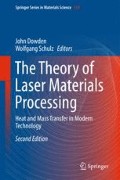Abstract
Methods by which physical laws can be converted into mathematical form as partial differential equations are discussed. Associated with these equations are boundary conditions, or the conditions to be applied at the interface between regions in which different regimes apply, represented by a discontinuity in some or all aspects of the variables describing the mathematical system. The manner in which the form of these conditions can be deduced is considered. The principles described are illustrated by application to some of the physical laws at the centre of laser technology.
Access this chapter
Tax calculation will be finalised at checkout
Purchases are for personal use only
Notes
- 1.
Indeed, Galileo went even further. The Assayer contains his well-known statement that mathematics is the language of God (https://en.wikipedia.org/wiki/The_Assayer).
- 2.
References
Steen WM (1998) Laser material processing, 2nd edn. Springer, Berlin
von Allmen M, Blatter A (1995) Laser beam interaction with materials: physical principles and applications. Springer, Berlin
Batchelor GK (1967) An introduction to fluid dynamics. Cambridge University Press, Cambridge
Dowden JM (2001) The mathematics of thermal modeling: an introduction to the theory of laser material processing. Chapman Hall/CRC, Boca Raton, Florida
Sone Y (2002) Kinetic theory and fluid dynamics, ch 5. Birkhäuser, Boston
Sharipov F (2004) Heat transfer in the Knudsen layer. Phys Rev E60(061201):1–4
Spitzer L (1962) Physics of fully ionized gases. Interscience, New York
Cohen RS, Spitzer L, Routly PMcR (1950) The electrical conductivity of an ionized gas. Phys Rev 80: 230–238
Author information
Authors and Affiliations
Corresponding author
Editor information
Editors and Affiliations
Rights and permissions
Copyright information
© 2017 Springer International Publishing AG
About this chapter
Cite this chapter
Dowden, J. (2017). Mathematics in Laser Processing. In: Dowden, J., Schulz, W. (eds) The Theory of Laser Materials Processing. Springer Series in Materials Science, vol 119. Springer, Cham. https://doi.org/10.1007/978-3-319-56711-2_1
Download citation
DOI: https://doi.org/10.1007/978-3-319-56711-2_1
Published:
Publisher Name: Springer, Cham
Print ISBN: 978-3-319-56710-5
Online ISBN: 978-3-319-56711-2
eBook Packages: Physics and AstronomyPhysics and Astronomy (R0)

